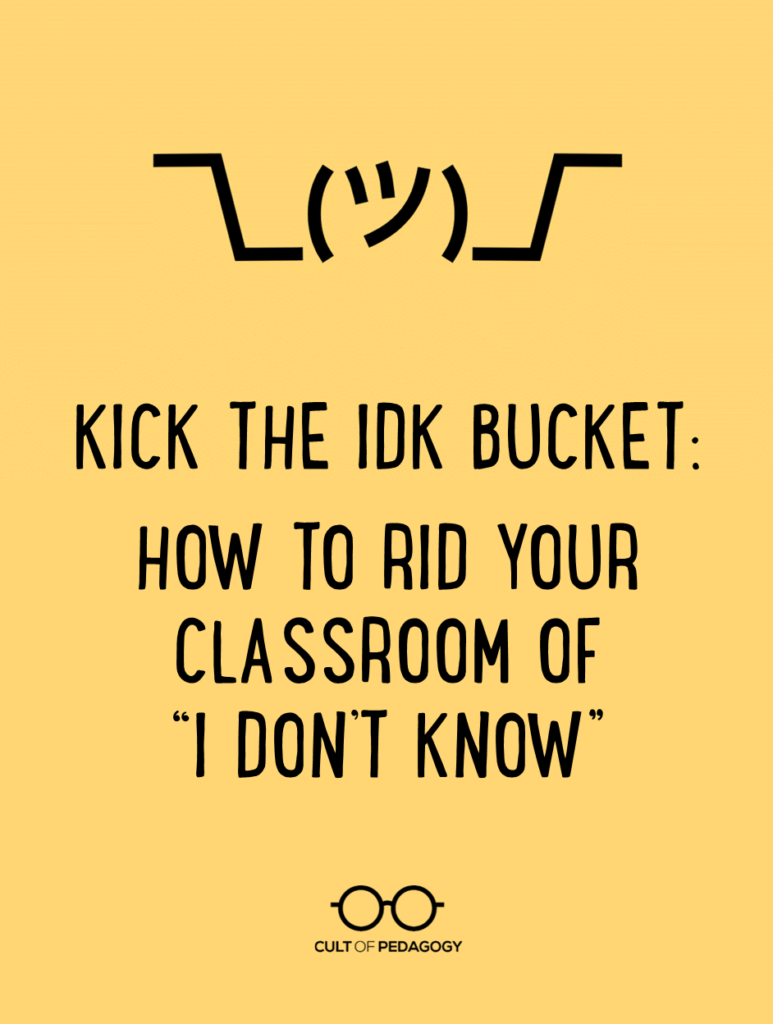
Listen to the interview with Connie Hamilton:
Sponsored by World101 and Listenwise
This page contains Bookshop.org links. When you make a purchase through these links, Cult of Pedagogy gets a small percentage of the sale at no extra cost to you. What’s the difference between Amazon and Bookshop.org?
We have all experienced it: Your lesson is rockin’ and you pause to check for understanding. Expecting to hear an elaborate student articulation of the deep learning occurring, you are jolted by three words: I don’t know. Students sometimes use this as a free pass to avoid thinking, taking a risk, or even responding to a question that they should be able to answer with a bit of effort.
Wouldn’t it be nice to eradicate “I don’t know” from your classroom? I am not suggesting that it isn’t acceptable for a student to literally not know. However, when a student recognizes they don’t know something, it should be a transition to knowing, not a termination of thinking.
I often label a variety of responses as IDK Responses, even if a student doesn’t actually utter the words. Shrugged shoulders, blank stares, or what I call “crooked eyebrows” are all indications to me that a student is not going to fare well on any check for understanding task that is given.
The Powerless “YET”
The growth mindset movement seems to have oversimplified the concept of perseverance. We see meme after meme that glorifies the power of YET. I’m just as supportive as the next person of students building a growth mindset when faced with a challenge. However, simply adding “yet” to IDK doesn’t prompt next steps. Fine—you don’t know yet. What are you going to do to fill that gap? Without a plan of action to overcome the IDK, y-e-t is just another three letter word with no action behind it.
Instead of letting students simply add “yet” to their “I don’t knows,” we’ll help them grow much further as learners if we get rid of IDKs altogether and teach students how to approach those deer-in-headlights moments more constructively.
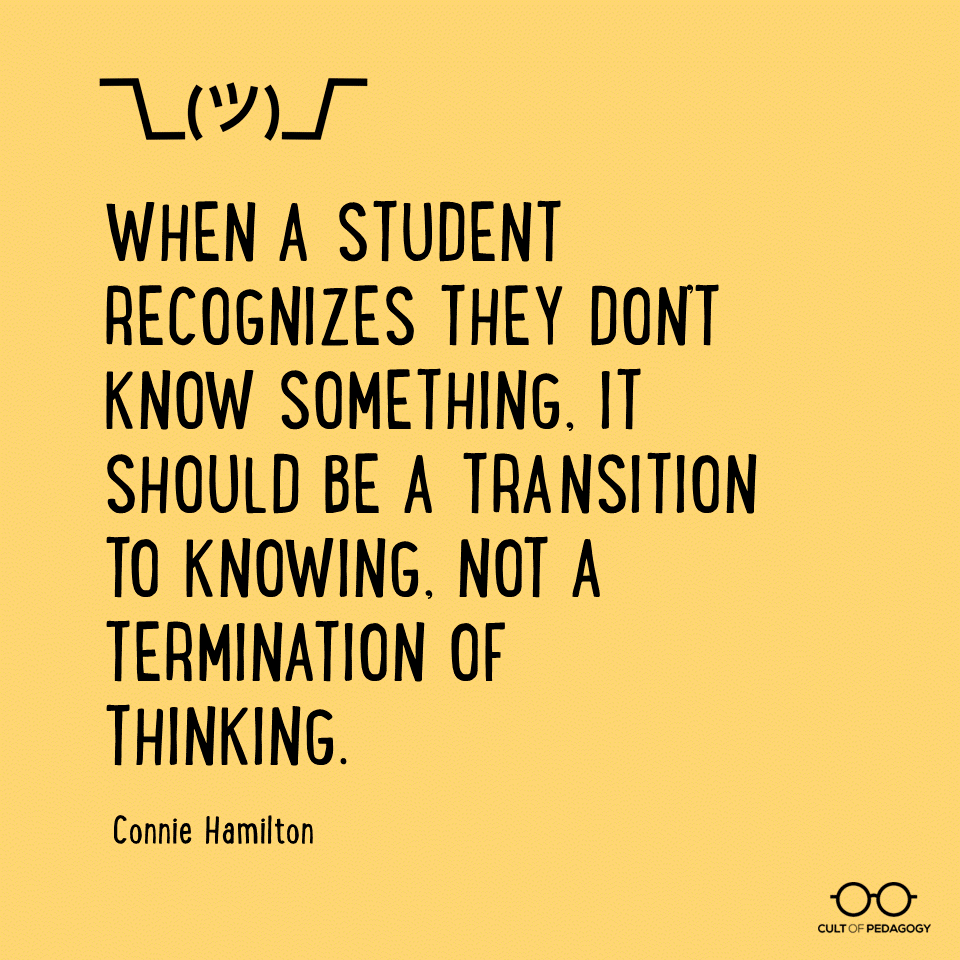
Ridding Your Classroom of the IDK
1. Start by Saying Goodbye
In order to put IDK to rest, we need to set a norm that prohibits its use in the classroom so that students stop seeing it as an option.
- A ceremony to rid students of their IDKs offers a memorable way to formalize the abolishment. One idea is to invite students to write their IDKs on a piece of paper. Then, as a class, host a funeral for their “I don’t knows.”
- If a ceremony is not your style, or if you think a “funeral” might hit too close to home for some students, try replacing the idea with burying, burning, or destroying IDKs. You can even tie it into recycling and repurpose the IDK into more productive phrases.
- A class meeting about the limits IDK places on their opportunity to learn and grow can be a simple, clear way to communicate to your students that you’re no longer going to accept it as an answer.
Any way to physically, visually, or verbally rid the classroom of the forbidden phrase is the first step in kicking the IDK bucket.
2. Explore the Reasons Behind the Response
When students are faced with a challenge that interferes with their ability to respond with ease, many don’t know how to respond, so they default to the generic “I don’t know.” But there are many causes for a student to offer an IDK—and it isn’t always because they actually lack understanding.
This makes it hard for us as teachers to know how to respond. A mismatched response to a student’s IDK can make it worse for everyone. For example, if a teacher has a plan to wait out students, thinking we are providing learners with additional think time, we are going to be waiting a loooong time if the student didn’t hear the question in the first place. Not knowing the antecedent creates challenges for both students and teachers, so start by helping students get clear on what’s behind their “I don’t know.”
Brainstorm with students all the actual reasons they might use “IDK” as a response. You might hear responses like:
- I didn’t hear the question.
- I didn’t understand the question.
- I couldn’t think of the answer quickly enough.
- I don’t like talking in front of the class.
- I am not sure if my answer is right.
- I really don’t know the answer.
3. Offer Alternatives
After helping students identify the reason behind their IDKs, have them come up with more precise language to describe the barrier they’re facing, phrases or actions they can use in place of the generic “I don’t know” that will help them with these speed bumps to learning and engaging. Posting these co-created alternatives to IDK in the room as a reminder for more productive responses can serve as a cue to students when tempted to use the banned phrase.
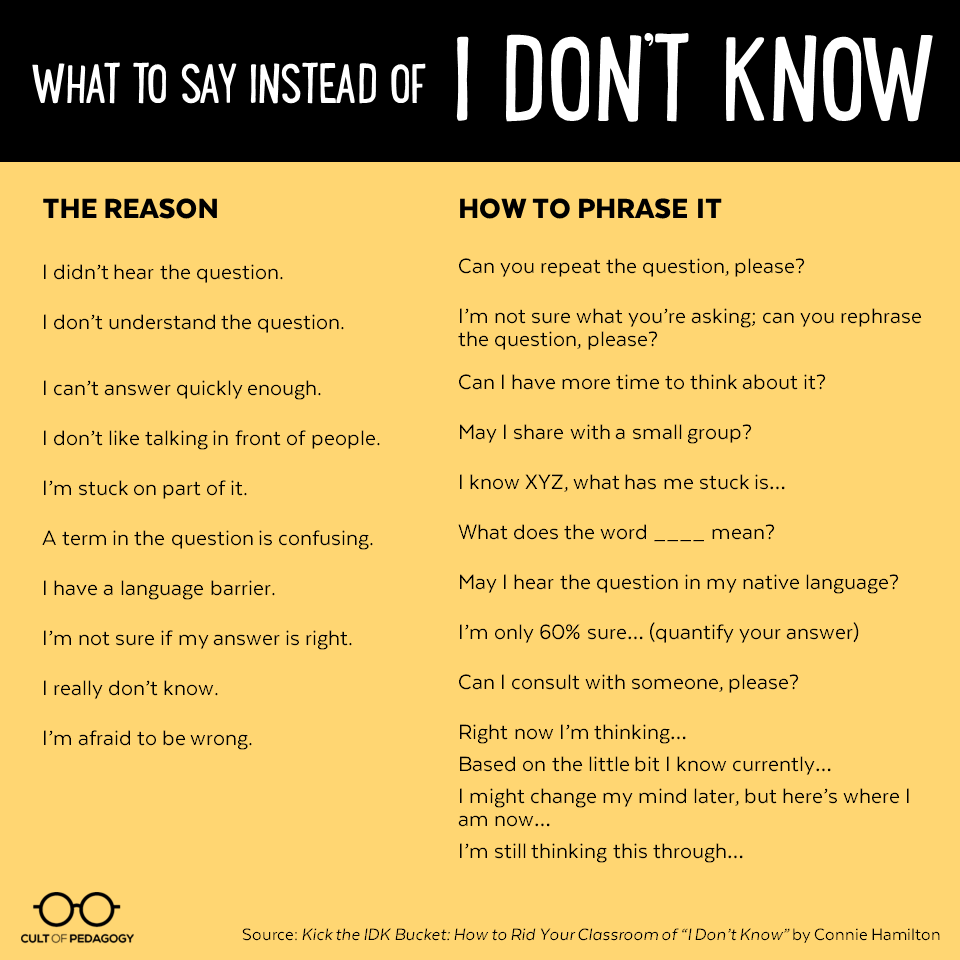
The last row of this chart is worth noting because of the opportunities it gives students for greater risk-taking, qualifying statements many of us use as adults to allow us to save face if our current thinking turns out to be wrong. Sharing these options with students might replace IDK with a verbal indication that the learner is about to go out on an academic limb.
On the path to mastery, we regularly encounter learning gaps. Allowing IDK to serve as a cognitive roadblock brings learning to a screeching halt. If we can recognize those moments as learning barriers that require us to find a more open road, we will keep student momentum progressing forward. Transforming “I don’t know” into a detour from uncertainty to the attainment of new knowledge would give IDK a new meaning in our schools.
To learn more from Connie, browse the free resources and posters she offers on her website. There are downloadables for supporting IDK responses and other strategies. Also check out her book, Hacking Questions: 11 Answers that Create a Culture of Inquiry in Your Classroom.
Join our mailing list and get weekly tips, tools, and inspiration that will make your teaching more effective and fun. You’ll get access to our members-only library of free downloads, including 20 Ways to Cut Your Grading Time in Half, the e-booklet that has helped thousands of teachers save time on grading. Over 50,000 teachers have already joined—come on in.

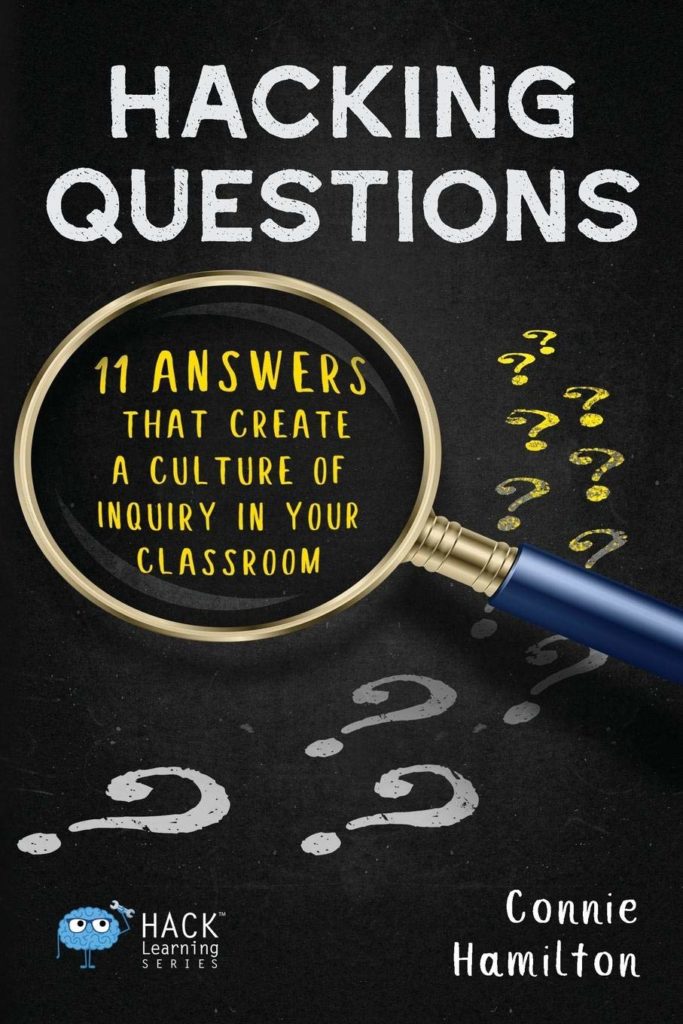
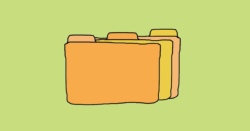


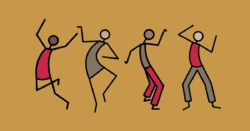
I love this article! This is something I struggle with in my classroom. I will try these alternative’s! My question- is there a way to get the graphics you’ve used? I would love to use them as anchor charts!
Thank you!
So glad to hear this, Tina! If you scroll down to the bottom of the post, there’s a link to Connie’s website. There, you’ll find lots of free posters and resources which include all the wonderful suggestions from the post and more!
Tina – I have several posters you can download for free that highlight the key points in Hack 2: Kick the IDK Bucket from Hacking Questions. If you don’t find what you’re looking for there, contact me directly and let me know what you need.
hackingquestions.com/resources
Great post thanks for sharing this valuable information with us all. I don’t know is the type of word that can ruin a lot of pleasant classes in seconds and many teachers try to avoid it by preparing themselves rigorously so that they can avoid it but it’s hard without proper guidelines to some. Your post definitely help help in providing the proper guidelines and help avoid this IDK mess. Nice work keep it up.
I’m glad you found it useful. We all need appreciate having tools and language to communicate lack of confidence on an answer or how to share what we need to fill in blanks when we really don’t know something.
Nice article.thanks
Hii, I am very amazed after hearing this content. It is very useful and helpful. This will help a lot to get rid of this IDK problem. It is very innovative way to change students and teachers prospective towards learning.
Thank You very much.
Thanks for listening, Suman. Jenn will be happy to know you enjoyed the podcast!